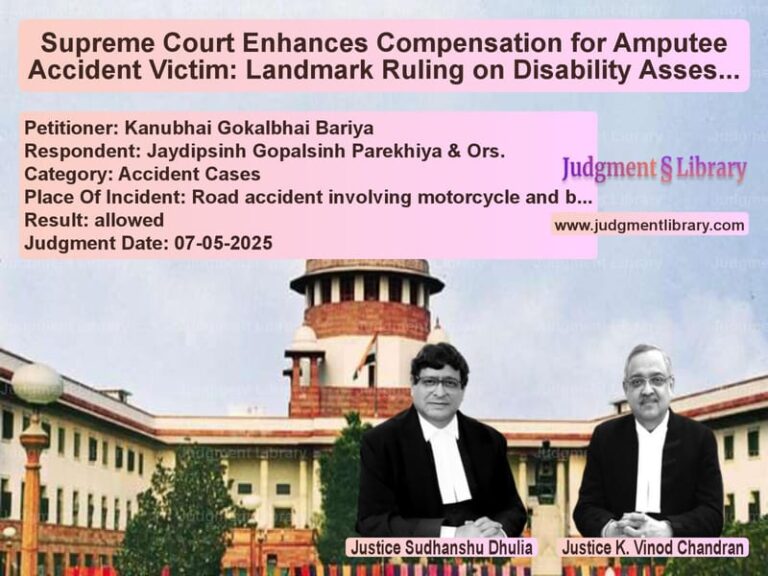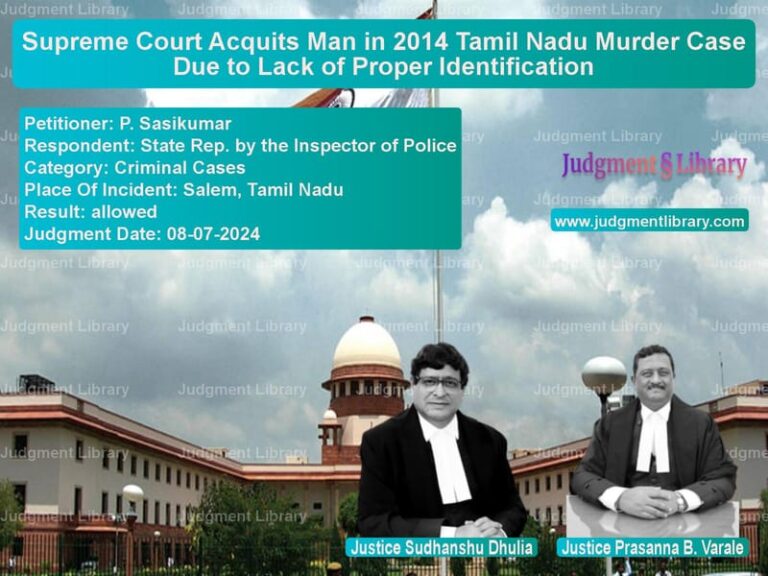Custodial Death and Police Brutality: Supreme Court’s Critical Ruling
The recent judgment of the Supreme Court in the case of Manik & Others v. State of Maharashtra has brought to light the serious issue of custodial torture and the misuse of power by law enforcement authorities. The case deals with the tragic custodial death of Shama @ Kalya, a history-sheeter who was allegedly tortured by police officers and whose body was later found mutilated and burned. The judgment has significant implications on the legal framework surrounding custodial violence and the responsibilities of law enforcement agencies.
Background of the Case
The case stems from the illegal detention and alleged custodial torture of Shama @ Kalya, a suspected criminal, by police officials in Gondia, Maharashtra. He was taken into police custody on December 7, 1995, in connection with a house-breaking and theft case. However, instead of following proper legal procedures, the police allegedly subjected him to third-degree torture, leading to his death.
The police allegedly attempted to cover up the incident by disposing of the body in a remote forest area in Madhya Pradesh and creating false records to indicate that the deceased had escaped from custody. On December 31, 1995, a charred and mutilated body was found in a forest under the jurisdiction of Tirodi police station. The prosecution alleged that the police officers had staged an escape scene and planted false evidence to mislead authorities.
Legal Proceedings and Arguments
Prosecution’s Case
- The police illegally detained the victim without formally registering his arrest.
- The victim was tortured while in police custody, leading to his death.
- The accused police officers conspired to cover up the custodial death by fabricating evidence, including planting a lookalike impersonator to fake an escape.
- The charred remains discovered in the forest were identified as those of the victim through forensic analysis and fingerprint comparison.
Defense’s Arguments
- The victim was not killed in custody but had actually escaped, as recorded in official police registers.
- The body found in the forest was not that of the victim but of an unidentified person.
- The prosecution failed to conclusively establish the identity of the body found, casting doubt on the entire case.
Supreme Court’s Observations
Justice C.T. Ravikumar, in his judgment, highlighted:
“The evidence in relation to efforts made by the accused persons to mutilate the said body and thereby destroy the evidence are rendered like a hazy picture and do not constitute proof of charge under Section 302 of Indian Penal Code.”
The court noted that while the prosecution had established custodial torture, there were discrepancies in proving the custodial death of the victim beyond reasonable doubt. The court ruled that in the absence of irrefutable forensic evidence linking the dead body to the victim, the accused could not be convicted of murder (Section 302 IPC).
Key Findings and Judgment
- The police officers were acquitted of murder charges due to lack of conclusive evidence linking the dead body to the victim.
- They were, however, convicted under Sections 330 (voluntarily causing hurt to extort confession), 348 (wrongful confinement), and 387 (extortion by putting a person in fear of death) of the IPC.
- The Supreme Court criticized the police’s attempt to mislead the court but refrained from imposing the harshest punishment due to gaps in forensic evidence.
- The court acknowledged that custodial deaths remain a serious issue and emphasized the need for stricter legal mechanisms to prevent police excesses.
Implications of the Judgment
The Supreme Court’s decision sets an important precedent regarding custodial violence and the burden of proof in cases involving police misconduct. The ruling highlights the following legal principles:
- Burden of Proof: In custodial death cases, the prosecution must provide clear forensic evidence linking the body to the victim.
- Police Accountability: The ruling reinforces the need for independent oversight over police conduct to prevent abuse of power.
- Legal Reform: The case underscores the urgency of implementing judicial reforms to handle custodial violence cases more effectively.
Conclusion
The judgment in Manik & Others v. State of Maharashtra is a critical examination of custodial violence and the challenges in prosecuting police officers for misconduct. While the ruling acknowledges the occurrence of custodial torture, it also highlights the difficulties in proving custodial deaths due to manipulated evidence and procedural lapses. The case serves as a reminder of the urgent need for stricter legal frameworks to hold law enforcement officials accountable for human rights violations.
Petitioner Name: Manik & Ors..Respondent Name: The State of Maharashtra.Judgment By: Justice C.T. Ravikumar, Justice Sanjay Kumar.Place Of Incident: Gondia, Maharashtra.Judgment Date: 25-09-2024.
Don’t miss out on the full details! Download the complete judgment in PDF format below and gain valuable insights instantly!
Download Judgment: manik-&-ors.-vs-the-state-of-maharas-supreme-court-of-india-judgment-dated-25-09-2024.pdf
Directly Download Judgment: Directly download this Judgment
See all petitions in Custodial Deaths and Police Misconduct
See all petitions in Attempt to Murder Cases
See all petitions in Fraud and Forgery
See all petitions in Judgment by C.T. Ravikumar
See all petitions in Judgment by Sanjay Kumar
See all petitions in partially allowed
See all petitions in Modified
See all petitions in supreme court of India judgments September 2024
See all petitions in 2024 judgments
See all posts in Criminal Cases Category
See all allowed petitions in Criminal Cases Category
See all Dismissed petitions in Criminal Cases Category
See all partially allowed petitions in Criminal Cases Category







